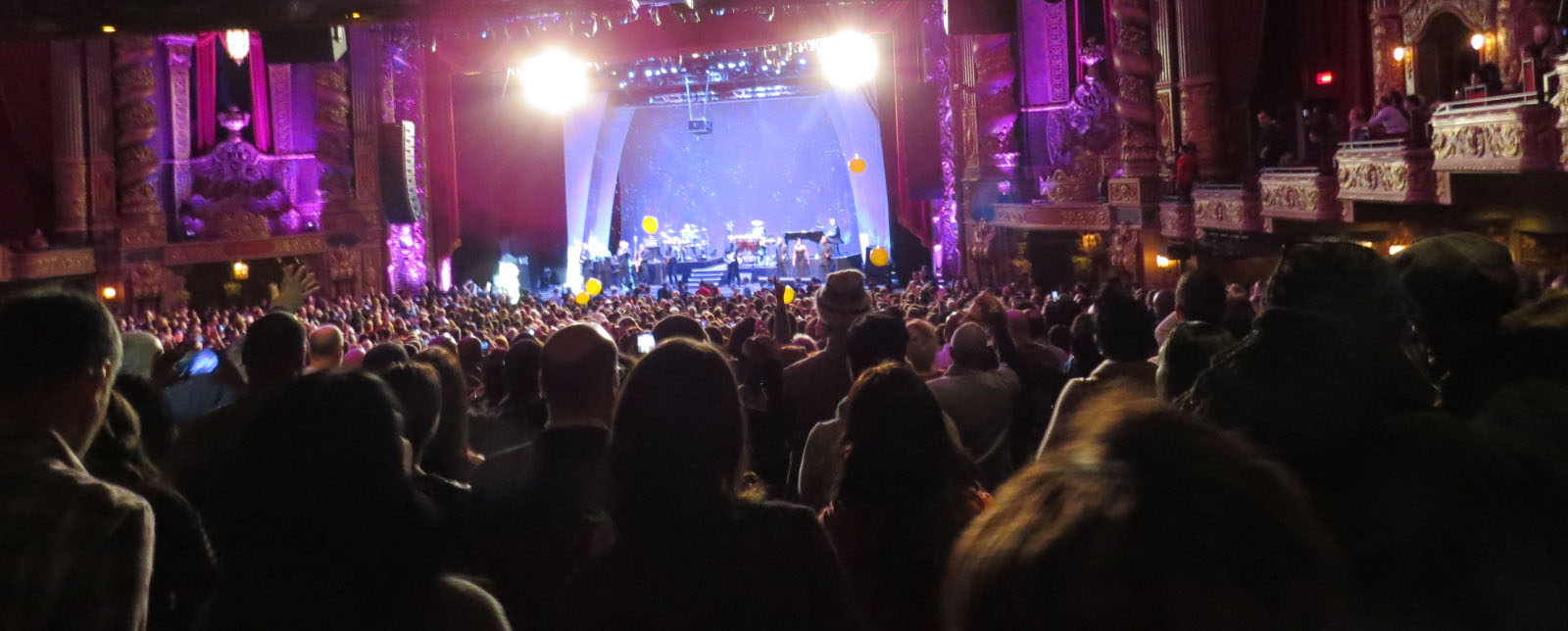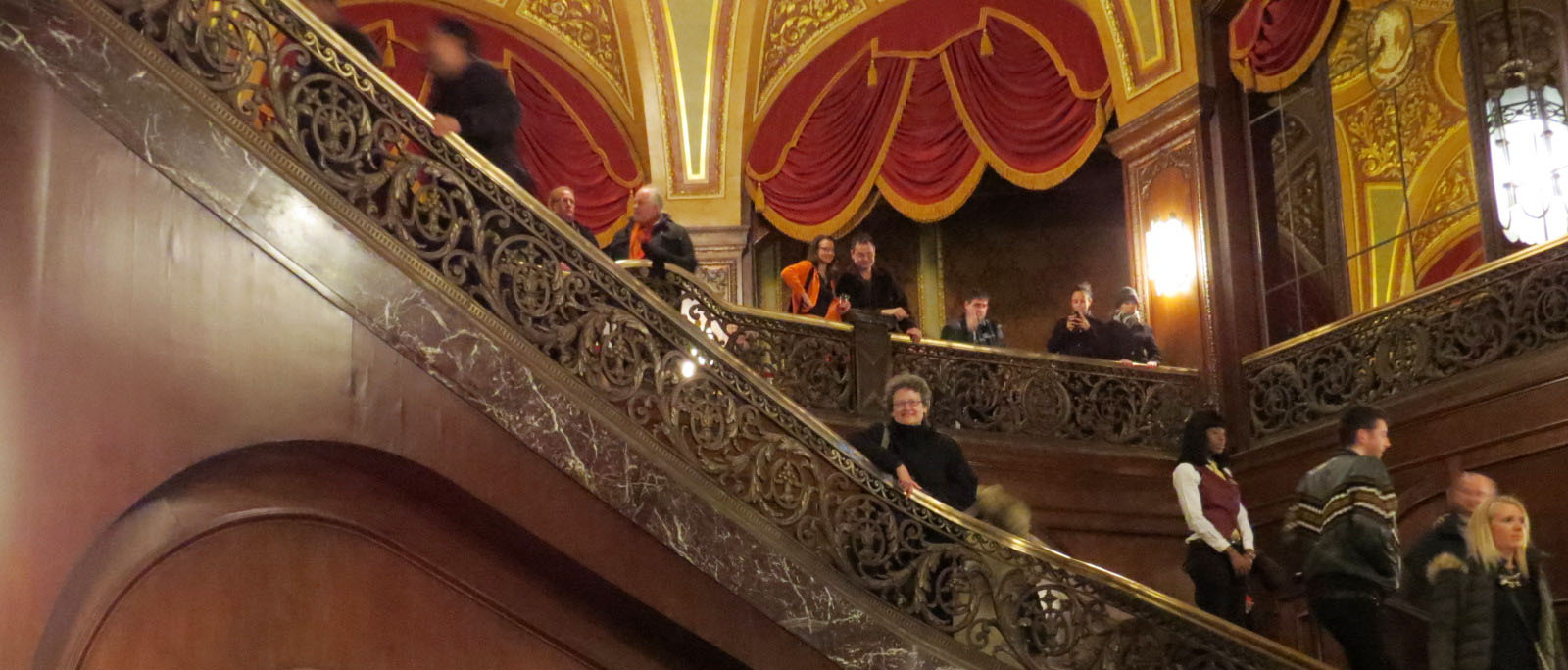Entries in Flatbush (4)
The Kings meets a queen

Once upon a time, back in the 1980s, a group of people entered a cavernous, darkened building on Flatbush Avenue. A flashlight played around the vast interior, revealing dull glints of gilded faces, flaked with decay...plants sprouting from a black, moldy carpet...sprung velvet seats sifted over with dust. The beam was too weak to illuminate more than a hint of the infinitude of rococo columns and alcoves that lurked in the shadows. We stood on a tour of "Brooklyn's Haunted Places" in the padlocked ruin of the Loew's Kings Theater, one of the original "Wonder Theaters" built to transport New Yorkers into a cinema fantasy world. Opened in 1929 and shuttered ignominiously in 1977, the Kings was almost certainly slated for demolition--if anyone in the drifting and dysfunctional city could summon the will to knock it down. The Spouse and I were a young couple on that tour--new homeowners in Flatbush, a place as steeped in myth as it was marooned in decline.
Flash forward almost 30 years. The couple, still Flatbushers, are back, with their 19-year-old daughter, on the opening night for the gloriously restored Kings. The kickoff concert, fittingly, is another indestructible grand dame: Miss Diana Ross, resplendent in an array of glittering costume changes, belting out her catalog of hits to a rapturous crowd of pure 2015 Brooklyn: Caribbean families, hipsters, diva-worshiping gay guys, and newly minted senior citizens who came here for movie dates and graduations from nearby Erasmus High School back in "the day."
 Diana praised the beauty of the space: "I feel like a queen! Can we turn up the house lights?" They never went high enough for me to get any shots that convey the red-and-gold palette, but you get the idea:
Diana praised the beauty of the space: "I feel like a queen! Can we turn up the house lights?" They never went high enough for me to get any shots that convey the red-and-gold palette, but you get the idea:
The restoration is stupendous. (For a good rundown, go here.) The same vintage as Radio City Music Hall, the Kings lacks its exuberant Deco quirkiness, going instead for a dreamlike palatial vibe.
The original had an Old World patina, which has been painstakingly recreated to yield a slightly sepulchral luxe, a perfect prom palace for funky vampires. Walnut paneling, caryatids, alcoves, columns, spin and overwhelm. Imagine sitting here in the depths of the Depression, watching Fred and Ginger (and a newsreel, and cartoons), shown to your seat by white-gloved usherettes.
Speaking of whom, the Kings team on opening night was terrific, doing a firm and friendly job of herding 3,600 of us--a full house--through metal detectors (alas) and to our cushy seats. They did their predecessor Barbra Streisand proud. I expected the politicos on hand, including Mayor DiBlasio (or, as the Daughter calls him, "Mr. Potato Head") and the irrepressible Marty Markowitz (who never gave up hope for the Kings) to babble at us, but they seem to have gotten that out of the way days earlier at a ribbon-cutting.
 Here she is, Brenda from Flatbush (my longtime Interwebs handle), descending the grand stair. As we left, a charter bus was filling up (we joked that they had come from Park Slope). We walked home through the snowy streets, past jerk chicken shops and a pawn broker and the construction pit where a new hotel will soon rise on Flatbush Avenue...past Erasmus, whose courtyard hides an ancient building awaiting its turn at renovation...past the Dutch Reformed Church, whose spire has gazed down on this village intersection since the American Revolution...past its churchyard, where slaveholders rest beneath Dutch-inscribed tombstones. Past and future whirled together (not to mention the sensory overload from having sung
Here she is, Brenda from Flatbush (my longtime Interwebs handle), descending the grand stair. As we left, a charter bus was filling up (we joked that they had come from Park Slope). We walked home through the snowy streets, past jerk chicken shops and a pawn broker and the construction pit where a new hotel will soon rise on Flatbush Avenue...past Erasmus, whose courtyard hides an ancient building awaiting its turn at renovation...past the Dutch Reformed Church, whose spire has gazed down on this village intersection since the American Revolution...past its churchyard, where slaveholders rest beneath Dutch-inscribed tombstones. Past and future whirled together (not to mention the sensory overload from having sung  "Stop! In the Name of Love" with Diana). I hope the Kings signals the resurrection of a Flatbush as crazily quilted as the one we stopped in and love...and not that it heralds the scourge of gentrification that would drive out the very kind of working folks who dreamed and celebrated in its glorious space all those years ago.
"Stop! In the Name of Love" with Diana). I hope the Kings signals the resurrection of a Flatbush as crazily quilted as the one we stopped in and love...and not that it heralds the scourge of gentrification that would drive out the very kind of working folks who dreamed and celebrated in its glorious space all those years ago.
"Hitherto Impossible": The Man Behind the Flatbush Panorama
Last entry, I posted a 1907 bird's-eye shot of Prospect Park South, and someone wondered about the source of the photo (which I grabbed off the web). Wow, glad you asked! First, here's a redo of the panorama, with Informative Labels By Me. Yes, that is a golf course between Stratford and Rugby Roads, south of the Parade Grounds; the march of development had already devoured the first hole, and the rest of the links weren't long for this world. CLICK THUMBNAIL FOR FULL-SIZED AWESOMENESS!
 Turns out, this is a rare New York shot by the ascended (literally) master of early aerial photography, George E. Lawrence (1868-1938). On the frustrating cusp of the era of aviation, this Illinois commercial photographer created crazy but effective contraptions to take panoramic pictures from the sky, including "captive airships" made of tethered kites
Turns out, this is a rare New York shot by the ascended (literally) master of early aerial photography, George E. Lawrence (1868-1938). On the frustrating cusp of the era of aviation, this Illinois commercial photographer created crazy but effective contraptions to take panoramic pictures from the sky, including "captive airships" made of tethered kites  and balloons. (He fell out of one such balloon, but then, he also experimented with flash charges for indoor photography and blew his child out a window. Both survived.) His daring extended to his personal life; the bounder ditched his first wife for his much-younger secretary.
and balloons. (He fell out of one such balloon, but then, he also experimented with flash charges for indoor photography and blew his child out a window. Both survived.) His daring extended to his personal life; the bounder ditched his first wife for his much-younger secretary.
Lawrence is most famous for his panorama of San Francisco lying in ruins after its great earthquake and fire. But he built a lucrative business photographing anything that called for a bird's-eye view. A glance at a gallery of his images evokes American values in the Teddy Roosevelt era. Bigger was better! He built the biggest camera in the world to capture a mighty steam engine, and shot political conventions, stockyards, factory floors, and military groups. But I'm particularly fond of his Big Crowds. Check out the sheer scale of the "Coliseum Gardens" somewhere, I think, in the Midwest:
 Coliseum Gardens, 1905 (Geo R. Lawrence, Library of Congress)
Coliseum Gardens, 1905 (Geo R. Lawrence, Library of Congress)
Can you imagine being a waiter in this place...or a dishwasher?
Banquets were another favorite subject; flocks of men in penguin suits paid Lawrence handsomely to record their festivities. This laugh-packed affair is a "party for Secretary Taft," and features, I believe, exotically costumed, long-suffering waiters (along with a centerpiece that redefines "farm-to-table eating"):
 Secretary Taft's Party Dinner, 1906 (Geo R. Lawrence, Library of Congress)
Secretary Taft's Party Dinner, 1906 (Geo R. Lawrence, Library of Congress)
Lawrence's services were expensive, and I wonder whether perhaps Dean Alvord, the developer of Prospect Park South, hired him to immortalize and promote the fabulous new development in Flatbush, which the Brooklyn Eagle termed "a rising colony of notables" in "a high class aristocratic suburb, the tone and character of which could not be disturbed or changed for a long period to come." (Job done!) I have found no information on what zany stunts were employed to capture the image, but I love the idea of the mustachio'd Mr. Lawrence, on a clear day more than a century ago, rigging up one of his "captive airships" over our sylvan streets.
"Is this world protected?"

This was the scene post-Irene: one Ent, still standing at its post a foot from our front porch, and leaves and branchlets littering the front yard. That's it. We were spared the wrath of nature. No power loss, roof damage, or flooded basement. This week, life seems suddenly very sweet and precious and good, in the most arbitrary of ways.
When you live in a century-old, freestanding wooden box with a five-story maple growing out from under it, you take Apocalyptic Hurricane Warnings (AHWs) seriously. Heck, our next-door neighbor nailed up plywood over his front windows. We opted for a strategy of cowering and watching lots of television. About 3 a.m. Sunday morning, when the AHWs ramped up from "tornado warning" to "tornado watch," I went a little nuts. Because (a) we have had a tornado touch down a block away, and (b) my fear of tornadoes is morbid, even by scared-of-scary-things standards. And thus did I do what I formerly sneered at: I packed a "Go Kit."
 The "Go Kit" has been a long-standing joke in the Crazy Stable. Years ago, Spouse obtained one somewhere; it contains, among other ludicrous articles, a cheap rain poncho and a Band-Aid. Whereas I have always felt that the only Go Kit worth having would contain firearms and a lot of cash. Now, as the winds swooshed outside, I seriously contemplated what to take to the basement if we might emerge to a pile of boards and wet rubble. And what about rounding up the pets? After a direct hit; what do we do with two carriers stuffed full of four idiot cats? Ask FEMA for kitty litter?
The "Go Kit" has been a long-standing joke in the Crazy Stable. Years ago, Spouse obtained one somewhere; it contains, among other ludicrous articles, a cheap rain poncho and a Band-Aid. Whereas I have always felt that the only Go Kit worth having would contain firearms and a lot of cash. Now, as the winds swooshed outside, I seriously contemplated what to take to the basement if we might emerge to a pile of boards and wet rubble. And what about rounding up the pets? After a direct hit; what do we do with two carriers stuffed full of four idiot cats? Ask FEMA for kitty litter?
I flung a few days' worth of clothes into a bag along with my camera, a flashlight, and some of the one zillion D batteries I'd scored on Saturday. I added my bedroom slippers, picturing myself in a shelter and comforted by their presence under my cot. Grabbed my few good rings; couldn't find my one good necklace. (Burglars, don't even bother.) Jammed in a zip-lock bag of important documents, including our passports so we could move to a less eventful country if need be. (How about Luxembourg? Nothing seems to happen there.)
But what about the other stuff I'd always thought I'd grab in the proverbial fire? Our wedding album? My box of family recipes? A few precious tchotchkes? Curiously, none seemed very important. I did tuck in my dad's old Latin/English Catholic missal, and his New Testament still lightly pencil-marked from his convert studies. And, as when I take a plane, I put his "miraculous medal" around my neck. Even from the next world, my dad makes me feel protected.
 I insisted that Spouse and I take turns sleeping and keeping a vigil for tornado warnings. (This after an argument about whether Flatbush had secret tornado sirens.) One reporter, Tony Aiello, passed within blocks of our house in a live-TV van, which was strangely reassuring. As Irene's less-than-apocalyptic bluster became apparent, we both dozed off, awakening to a mere lashing rain storm followed by whipping winds and clearing skies. The Ent's massive trunk swayed like a ballerina's supple spine; the roots that torment my gardening efforts held fast. We were protected. No cat carriers, basement huddle, bottled water or D batteries needed.
I insisted that Spouse and I take turns sleeping and keeping a vigil for tornado warnings. (This after an argument about whether Flatbush had secret tornado sirens.) One reporter, Tony Aiello, passed within blocks of our house in a live-TV van, which was strangely reassuring. As Irene's less-than-apocalyptic bluster became apparent, we both dozed off, awakening to a mere lashing rain storm followed by whipping winds and clearing skies. The Ent's massive trunk swayed like a ballerina's supple spine; the roots that torment my gardening efforts held fast. We were protected. No cat carriers, basement huddle, bottled water or D batteries needed.
Now, with the videos of heartbroken folks who lost everything, comes the mingled relief and unease. What if we hadn't gotten off lightly; would God be to blame? Or my dad, for not stepping up and interceding? How much could I lose, and still remain friends with the invisible force that gives and guides my life? The wedding album, the house, even the cats, okay, but what of those I love? These questions are even scarier than the $25,000 hurricane deductible that I discovered in our State Farm policy.
Now it's time to rake up branchlets. And to wonder again why faith isn't as easy as it is in Doctor Who. Click the clip to see how it ought to work.
Unforgettable Flatbush: Graveyard Shift
 Last weekend's Forgotten New York walking tour took us to the heart of ridiculously historic Flatbush. It had been many years since I'd walked east to what used to be the heart of the village of Flatbush. We peeked in at Albemarle Terrace, and the group ached with real-estate longing, especially when several homeowners stopped to chat about life in this lovely enclave and its neighbor, Kenmore Terrace.
Last weekend's Forgotten New York walking tour took us to the heart of ridiculously historic Flatbush. It had been many years since I'd walked east to what used to be the heart of the village of Flatbush. We peeked in at Albemarle Terrace, and the group ached with real-estate longing, especially when several homeowners stopped to chat about life in this lovely enclave and its neighbor, Kenmore Terrace.
 This pre-Civil War gem was the rectory to the Dutch Reformed Church of Flatbush, and porches don't get any better than this.
This pre-Civil War gem was the rectory to the Dutch Reformed Church of Flatbush, and porches don't get any better than this.

Behind the house, now used for social programs, an effervescent young lady named Katie leaped out of a pile of leaves to explain composting. Behind us, tombstones in the ancient Dutch cemetery gave mute witness to a different sort of composting.
 This crossroads, at Church and Flatbush Avenues, goes back way before George Washington slept anywhere. Above us loomed the steeple of a church built in 1786 for a congregation founded in 1654. Around us flowed the hurly-burly of a working-class Caribbean community, which supplanted a well-off middle-class Jewish community, which took over a fading semi-rural village, which faded from a once-thriving Dutch farm town.
This crossroads, at Church and Flatbush Avenues, goes back way before George Washington slept anywhere. Above us loomed the steeple of a church built in 1786 for a congregation founded in 1654. Around us flowed the hurly-burly of a working-class Caribbean community, which supplanted a well-off middle-class Jewish community, which took over a fading semi-rural village, which faded from a once-thriving Dutch farm town.
 In the churchyard, we met up with Flatbush Gardener Chris Kreussling, a deeply knowledgeable garden coach who showed off the new native plantings in the Church Avenue communal garden. From these modest shady beginnings, he and his fellow volunteers envision a swath of greenery authentic to time and place; plantings include switch grass and one of my favorites, wild ginger.
In the churchyard, we met up with Flatbush Gardener Chris Kreussling, a deeply knowledgeable garden coach who showed off the new native plantings in the Church Avenue communal garden. From these modest shady beginnings, he and his fellow volunteers envision a swath of greenery authentic to time and place; plantings include switch grass and one of my favorites, wild ginger.  Around the back of the church, Anne Pope of Sustainable Flatbush and another brave soul were coaxing luxuriant crops from containers. (They all welcome helpers, by the way, if you're itching to get your hands dirty this summer.) Here's Chris with Kevin of Forgotten New York--proud to call them friends.
Around the back of the church, Anne Pope of Sustainable Flatbush and another brave soul were coaxing luxuriant crops from containers. (They all welcome helpers, by the way, if you're itching to get your hands dirty this summer.) Here's Chris with Kevin of Forgotten New York--proud to call them friends.

Yes, some of the tombstones are in Dutch, and the names are a who's-who of Brooklyn streets: Lefferts, Martense, Clarkson (he once owned the land our house is built on). The July sun drove all ghosts away, but at night some folks leave voodoo souvenirs scattered around (like a coconut shell we stepped around).
 Our last stop was that gothic masterpiece of Flatbush Avenue, the former Erasmus Hall High School, now broken into five smaller "academies" (the currently trendy solution for large failing schools). Erasmus should be the Hogwarts of Brooklyn, but no one seems to have cared enough to save it in its original incarnation (one that counted Barbra Streisand and Beverly Sills as graduates).
Our last stop was that gothic masterpiece of Flatbush Avenue, the former Erasmus Hall High School, now broken into five smaller "academies" (the currently trendy solution for large failing schools). Erasmus should be the Hogwarts of Brooklyn, but no one seems to have cared enough to save it in its original incarnation (one that counted Barbra Streisand and Beverly Sills as graduates).
 The academic decline is depressing; so is the atrocious neglect of its architectural treasure, in a quadrangle that dates back to school founders Alexander Hamilton and Aaron Burr (among others). This original school building is reportedly in near-ruins; students apparently know little of its history. A statue of Erasmus dominates the inaccessible courtyard; behind him, paint flakes off one of Flatbush's ignored treasures.
The academic decline is depressing; so is the atrocious neglect of its architectural treasure, in a quadrangle that dates back to school founders Alexander Hamilton and Aaron Burr (among others). This original school building is reportedly in near-ruins; students apparently know little of its history. A statue of Erasmus dominates the inaccessible courtyard; behind him, paint flakes off one of Flatbush's ignored treasures.
 Gentrification hasn't swept in to transform old Flatbush, but hard-working and passionate people still love it and fight for it to thrive. Its once-storied institutions serve new incarnations of this resilient community through our chronic struggles. (One tour member, Sarah, Kevin's cousin and a Ditmas Park blogger, used to teach at Erasmus and described the beauty of its interior. "And I won't say a word against those kids," she said with a passion that touched me.) Most of the passers-by probably don't know any more about the steeple and the graveyard than the kids know about Erasmus; we got passing funny looks from hurried shoppers for standing around staring at the cornices. But the truth of Forgotten New York is that traces remain, and the curious find out more, and fight to save what's left...while the city morphs relentlessly all around us.
Gentrification hasn't swept in to transform old Flatbush, but hard-working and passionate people still love it and fight for it to thrive. Its once-storied institutions serve new incarnations of this resilient community through our chronic struggles. (One tour member, Sarah, Kevin's cousin and a Ditmas Park blogger, used to teach at Erasmus and described the beauty of its interior. "And I won't say a word against those kids," she said with a passion that touched me.) Most of the passers-by probably don't know any more about the steeple and the graveyard than the kids know about Erasmus; we got passing funny looks from hurried shoppers for standing around staring at the cornices. But the truth of Forgotten New York is that traces remain, and the curious find out more, and fight to save what's left...while the city morphs relentlessly all around us.
